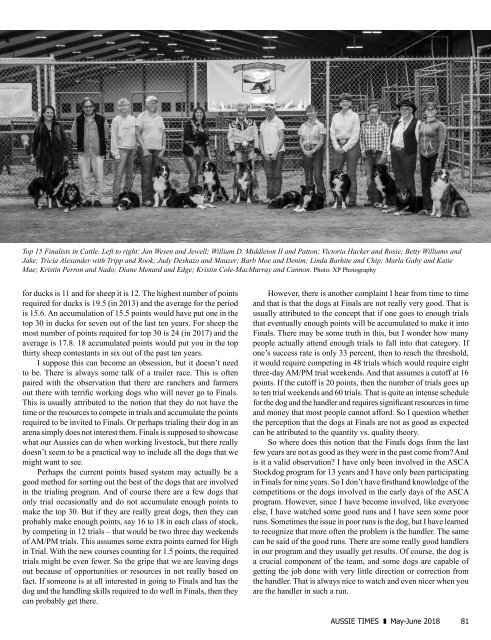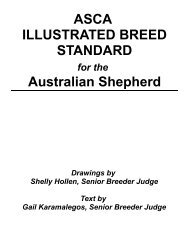2018 May June
You also want an ePaper? Increase the reach of your titles
YUMPU automatically turns print PDFs into web optimized ePapers that Google loves.
Top 15 Finalists in Cattle. Left to right: Jan Wesen and Jewell; William D. Middleton II and Patton; Victoria Hacker and Rosie; Betty Williams and<br />
Jake; Tricia Alexander with Tripp and Rook; Judy Deshazo and Mauzer; Barb Moe and Denim; Linda Barhite and Chip; Marla Gaby and Katie<br />
Mae; Kristin Perron and Nado; Diane Menard and Edge; Kristin Cole-MacMurray and Cannon. Photo: XP Photography<br />
for ducks is 11 and for sheep it is 12. The highest number of points<br />
required for ducks is 19.5 (in 2013) and the average for the period<br />
is 15.6. An accumulation of 15.5 points would have put one in the<br />
top 30 in ducks for seven out of the last ten years. For sheep the<br />
most number of points required for top 30 is 24 (in 2017) and the<br />
average is 17.8. 18 accumulated points would put you in the top<br />
thirty sheep contestants in six out of the past ten years.<br />
I suppose this can become an obsession, but it doesn’t need<br />
to be. There is always some talk of a trailer race. This is often<br />
paired with the observation that there are ranchers and farmers<br />
out there with terrific working dogs who will never go to Finals.<br />
This is usually attributed to the notion that they do not have the<br />
time or the resources to compete in trials and accumulate the points<br />
required to be invited to Finals. Or perhaps trialing their dog in an<br />
arena simply does not interest them. Finals is supposed to showcase<br />
what our Aussies can do when working livestock, but there really<br />
doesn’t seem to be a practical way to include all the dogs that we<br />
might want to see.<br />
Perhaps the current points based system may actually be a<br />
good method for sorting out the best of the dogs that are involved<br />
in the trialing program. And of course there are a few dogs that<br />
only trial occasionally and do not accumulate enough points to<br />
make the top 30. But if they are really great dogs, then they can<br />
probably make enough points, say 16 to 18 in each class of stock,<br />
by competing in 12 trials – that would be two three day weekends<br />
of AM/PM trials. This assumes some extra points earned for High<br />
in Trial. With the new courses counting for 1.5 points, the required<br />
trials might be even fewer. So the gripe that we are leaving dogs<br />
out because of opportunities or resources in not really based on<br />
fact. If someone is at all interested in going to Finals and has the<br />
dog and the handling skills required to do well in Finals, then they<br />
can probably get there.<br />
However, there is another complaint I hear from time to time<br />
and that is that the dogs at Finals are not really very good. That is<br />
usually attributed to the concept that if one goes to enough trials<br />
that eventually enough points will be accumulated to make it into<br />
Finals. There may be some truth in this, but I wonder how many<br />
people actually attend enough trials to fall into that category. If<br />
one’s success rate is only 33 percent, then to reach the threshold,<br />
it would require competing in 48 trials which would require eight<br />
three-day AM/PM trial weekends. And that assumes a cutoff at 16<br />
points. If the cutoff is 20 points, then the number of trials goes up<br />
to ten trial weekends and 60 trials. That is quite an intense schedule<br />
for the dog and the handler and requires significant resources in time<br />
and money that most people cannot afford. So I question whether<br />
the perception that the dogs at Finals are not as good as expected<br />
can be attributed to the quantity vs. quality theory.<br />
So where does this notion that the Finals dogs from the last<br />
few years are not as good as they were in the past come from? And<br />
is it a valid observation? I have only been involved in the ASCA<br />
Stockdog program for 13 years and I have only been participating<br />
in Finals for nine years. So I don’t have firsthand knowledge of the<br />
competitions or the dogs involved in the early days of the ASCA<br />
program. However, since I have become involved, like everyone<br />
else, I have watched some good runs and I have seen some poor<br />
runs. Sometimes the issue in poor runs is the dog, but I have learned<br />
to recognize that more often the problem is the handler. The same<br />
can be said of the good runs. There are some really good handlers<br />
in our program and they usually get results. Of course, the dog is<br />
a crucial component of the team, and some dogs are capable of<br />
getting the job done with very little direction or correction from<br />
the handler. That is always nice to watch and even nicer when you<br />
are the handler in such a run.<br />
AUSSIE TIMES <strong>May</strong>-<strong>June</strong> <strong>2018</strong> 81



